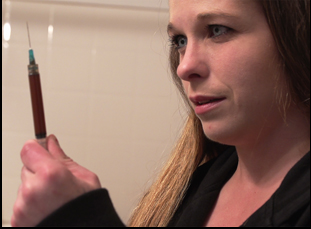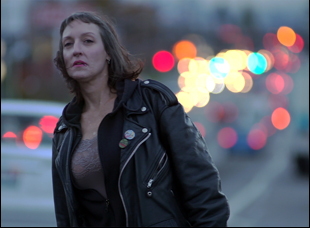In the production notes for “Sweetheart Deal,” Elisa Levine wastes no time in her director’s statement citing the influence of “Streetwise,” Mary Ellen Mark and Martin Bell’s landmark 1984 documentary about runaway teenagers living on the streets of Seattle, to which her wrenching first feature, co-directed with the late Gabriel Miller, will inevitably be compared. With time, there was an obvious opportunity to revisit the city and those who have been left behind as it becomes increasingly unaffordable for anybody who isn’t in its surging tech industry, setting up shop in the darker corners of the Emerald City on Aurora Avenue where the sun may be in short supply, but the night sky is lit with the neon signs of cheap motels where many have turned to sex work to make a living. However, Levine and Miller embraced a less obvious element in what made “Streetwise” so striking, investing close to the decade in the lives of the four women it tracks – Kristine, Tammy, Krista (who is introduced first by her street name Amy) and Sara — to tell their story with considerable empathy as they navigate a world that would seem to have little compassion for them.
It is easy to see then why they and others gravitate towards Laugh “Elliott” Doescher, a self-proclaimed “Mayor of Aurora,” whose parked RV becomes a refuge of sorts with the promise of a warm meal and a place to rest without judgment. As Sara attests early in “Sweetheart Deal,” “I really value the fact that I can knock on his door, crawl in bed and feel safe,” though by keeping the cameras rolling, Levine and Miller start to pick up that Doescher’s generosity isn’t as selfless as he would it make seem and the perspective of the young women isn’t entirely sound when they all turn to drugs to cope with the pain and trauma that’s all around them in their lives. “Sweetheart Deal” doesn’t flinch from depicting its subjects at their most vulnerable moments, but more impressively, the filmmakers’ dedication to telling their story in full yields a number of unexpected twists and adds the kind of context to their plight that often gets overlooked, illuminating the number of factors, both personal and socioeconomic, that can quickly lead to quicksand it’s all but impossible to emerge from.
Although Levine would surely refrain from suggesting a struggle anywhere near the same level, a longitudinal project involving such sensitive subject matter likely could feel like an endless black hole as well when the stories of the quartet of women becomes so sprawling, eventually involving a court case, and she lost her filmmaking partner Miller in 2019. Still, she emerges on the other side of it with a powerful chronicle of the day-to-day turbulence of those caught in a vicious cycle of being unhoused, given few opportunities to take even the first steps towards turning around their lives and fixated on seeking immediate relief rather than long-term care. Shortly before the film’s hometown premiere at the Seattle Film Festival, the director spoke about the risks and rewards of putting so much time and energy into “Sweetheart Deal” and how telling the story of a single street could open up an entire world for both those involved in the making of the film and those who will pass by places like Aurora in their own neighborhoods without giving much thought to it.
It started quite a while ago – over 10 years [now] – with an interest in Seattle’s Aurora Avenue, trying to understand what was going on beneath the surface there. It’s a side of town that exists in pretty much every major city that’s probably not on the postcards, but the part of town that everyone knows about. I was exploring stories around Aurora Avenue, but it wasn’t until around 2009 or so that I met Elliott, one of the subjects of the film [who] was really the first person who would really speak to us. Prior to that, I had just been wandering around Aurora, trying to get to know people, but it was very difficult [because] who am I? But he was someone who seemed to want his story told, so I think that’s why he jumped in front of the camera and through him, I ended up meeting all these people and following their stories, often without him as time went on.
You likely couldn’t have envisioned a decade-long investment of time, but did you know this would be a longitudinal project?
In retrospect, I think I had no idea. This has been a very, very long time. Gabriel, my co-director, and I were very interested in telling a very human and very real story and we knew that it was going to be a long project, whatever it ended up being because we wanted to do a verite, observational style film and I knew that you’re in for the long haul, as opposed to something where you’re just dropping in. We knew it was going to take a lot of time building trust and relationships and we didn’t know where the story was going to go or actually qhat it was in the beginning. It was evolving over time and we were there as they took shape.
What attracted you to the four women the film comes to focus on?
We met quite a few people while we were there and the four women that we ended up focusing on just really embraced us and wanted their stories told. Everybody had their own reason, and it takes a long time to develop a real connection, but you could see some people were letting us into their world and everyone’s from a little bit of a different background – some came from poverty, some came from actually very well-off families, once you get out there, none of that matters and all of them were dealing with the same stuff, due to heroin addiction. It’s an equal playing field out on Aurora and everybody has to deal with the same difficult stuff, especially when you’re managing an addiction and also doing sex work in order to feed that addiction.
Going through the edit process of this film has been really challenging, trying to figure out how to tell those stories and weave everyone’s story together. It was really important to us to show and not tell as much as possible, so we use a lot of voiceover, but there’s a very limited amount of [traditional] sit-down interviews and [we wanted to] tell little tidbits of everybody’s backstory. For example, the scene with Tammy and her parents in her living room, having that discussion and then [her] back in the bathroom, that little tidbit illustrates things so much better than we could ever do in say a narration situation or a sit-down interview because people can experience that themselves and have their own feelings about it without hearing the filmmakers’ voice.

For the most part, the women were estranged from their parents and we were really focusing on what was important to them to tell their story – we wanted to hear it coming from the women more than anything else. In that particular situation [with Tammy], that was a very difficult relationship with the parents and we also got to include Krista, formerly known as Amy [when she was living on Aurora], and some of Krista’s [relationship with her] mom, a really special person. I’m glad we got to include that because so much that you never get to hear about is a trauma what families go through when they have somebody who’s experiencing this deep addiction when you don’t know when you’re going to get that phone call and you don’t know where [their loved ones] are. They live for years in silence with that and with all the stigma that surrounds that where they feel they can’t talk to anyone about it, so I was really glad that we got include that a little bit because Krista’s mom was just so important to her and families often blame themselves when often it often doesn’t have anything to do [with them].
Aesthetically, this must be difficult to capture as well when you’re primarily filming on this one street and you’re dealing with all the sensitivities of the subject matter. Was it difficult to find the right camera style for it?
We were very aware that we were only guests in this world and that we were walking into the world of Aurora, which has its own set of rules. We were learning as we went along about everything to do with these women’s lives, so we were observers. Gabriel Miller was the cinematographer [in addition to being] my co-director and he just had a real vision for how he wanted to shoot this and as far as the aesthetics of Aurora Avenue itself, we wanted to capture a lot of the beauty of the neon lights and that feeling that you get from the area even amongst this place that just draws misery back again and again. Then as far as with shooting individuals and in cramped spaces, it was usually handheld camera in motel rooms and the RV and hospital rooms and places like that, and we didn’t have external lighting. It was natural light and y we were very aware to get good sound as well because that’s just so important. But it was a very challenging thing to film.

I’m really excited that it’s not a virtual festival and we actually go get to sit down in an actual movie theater and get to show this and what’s most on my mind about why this is important is that the women are going to get to be there and see this with an audience on the big screen. And they’re going to get to speak about what this meant to them, as much as they want to, and their experience, so they’ve been waiting for this and I’m just really happy for them. Also, Sara’s daughter Maddie is going to be there, and this film just means so much for her because she was largely estranged from her mom and just came back to getting to know her, so it’s like a way of her mom speaking to her through this film. As you could see in the film, that was so important to Sara, getting to get back with her kids [was] what she wanted and at least she got to reconnect with Maddie.
“Sweetheart Deal” will screen next at the Bend Film Festival at the This is Regal on October 7th at 7:45 pm and October 8th at 10:45 am. It will be available virtually in Oregon and Washington from October 10th through October 23rd.





